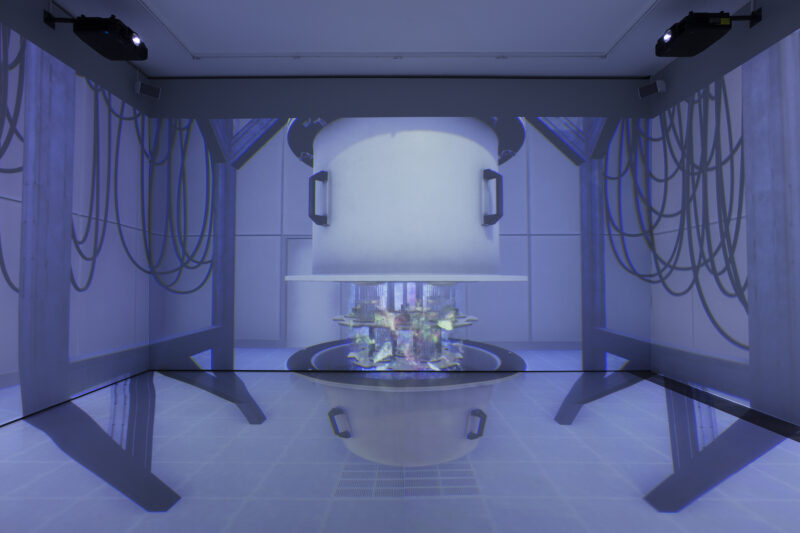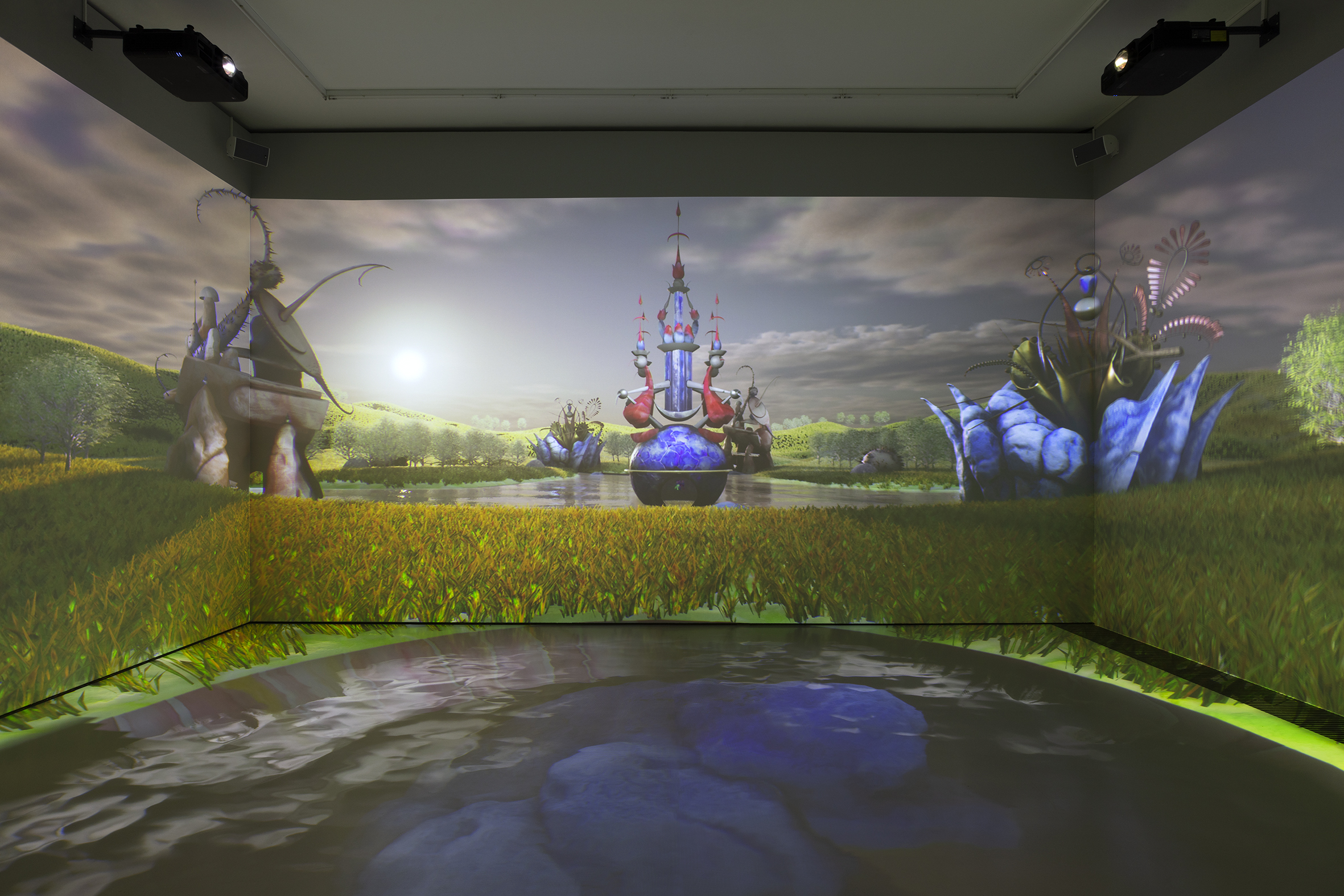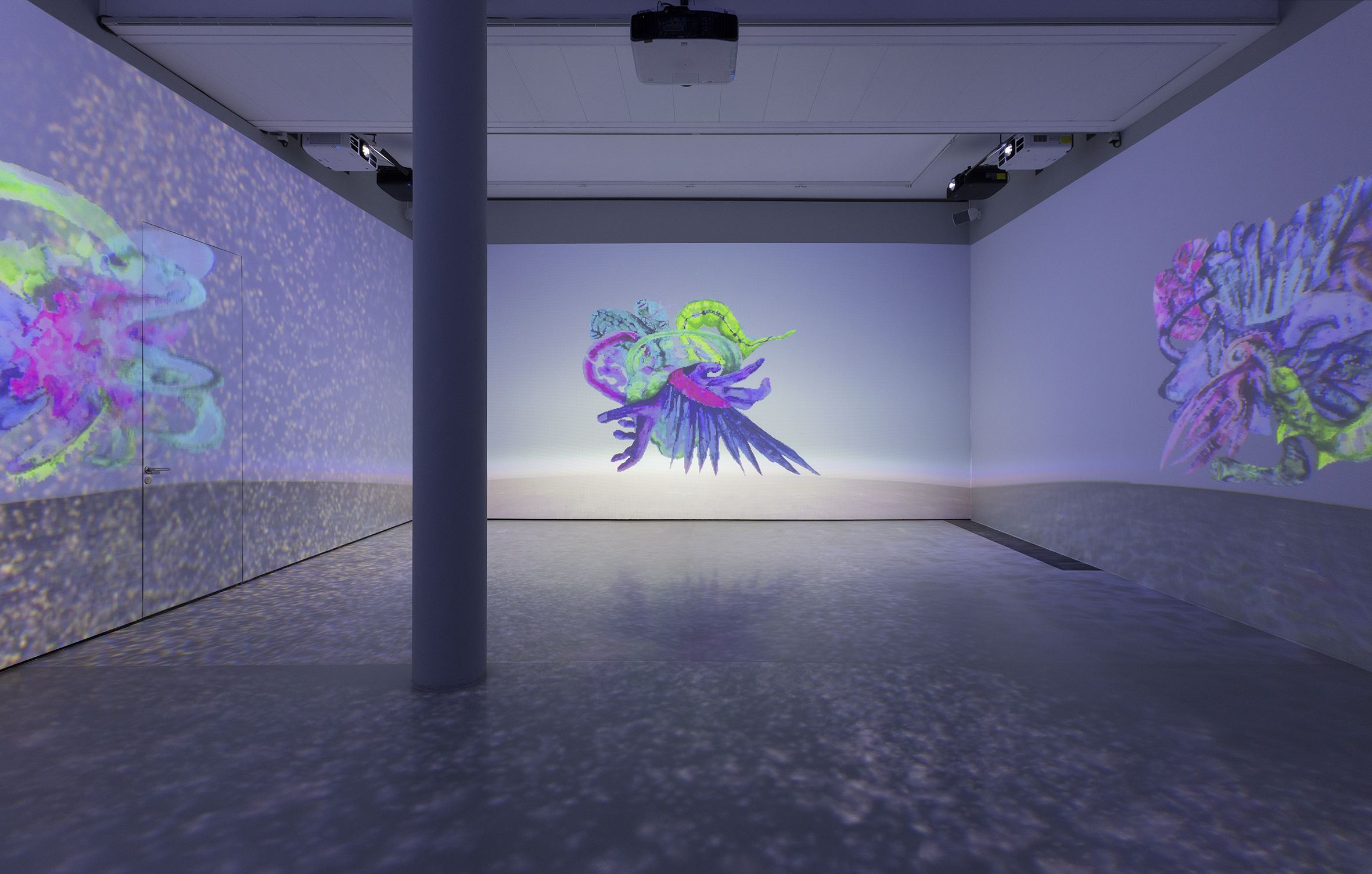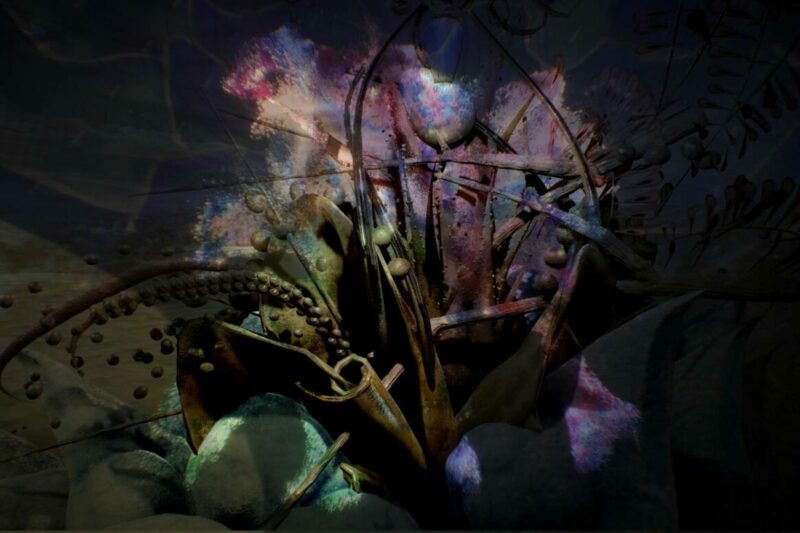by Adela Lovric // Feb. 28, 2022
Quantum computing—a new paradigm in computation that utilizes phenomena in quantum physics—is expected to make huge leaps forward in technology and profoundly affect life on Earth. With a substantial background in science, London artist and quantum physicist Libby Heaney is able to critically assess these developments and unpack the power structures around them through in-depth research and speculation. She lays out the complexities and the contingencies of this new world through art to a wider, non-scientific public. She also uses quantum computing as a functioning artistic medium and is a pioneer in that regard.
Commissioned by LAS (Light Art Space) and presented at the Schering Stiftung in Berlin, Heaney’s 360-degree immersive installation ‘Ent-’ unfolds as a quantum interpretation of Hieronymus Bosch’s painting ‘The Garden of Earthly Delights.’ Just like the central panel of Bosch’s triptych, ‘Ent-’ carries multiple meanings and can be seen, among other things, as a warning of the consequences of our contemporary desires. We spoke with the artist about her ongoing exhibition in Berlin, her art practice that meshes feminist theories and scientific expertise, and her predictions about a technological shift towards quantum computing.

Libby Heaney: ‘Ent-,’ installation view, Schering Stiftung, Berlin, 2022 // Photo: Andrea Rossetti
Adela Lovric: Before you became an artist, you were working in the field of quantum physics. Why was it important for you to bring these two worlds together and continue working with your scientific research topics in an art context?
Libby Heaney: I wanted to be an artist since I was young, but wasn’t really able to because I come from a low-income family. My family and teachers recommended that I study what they considered a more serious subject, like physics. Over time, when I was practicing physics, I was still making art. I felt it allowed me to express aspects of myself and how I saw the world in a way that science couldn’t. You try to take yourself out of science when you’re practicing it, whereas art is really interlinked with your identity. It took me ages to save up enough money to be able to fund myself through an arts degree. By that point, I had a huge background in quantum physics. There’s a lot of knowledge that can help us understand the world in a different way. For instance, when I was practicing science, my topic was entanglement, which is one of the key ingredients that scientists need to build a quantum computer but helps us think about relations in new ways. On the other hand, I was involved with this push towards understanding what a quantum computer is and no one was discussing the impacts that this really powerful new technology would bring to the world. That was one of my main concerns. When I left to pursue art, I knew that I could discuss quantum computing and other technologies from an informed viewpoint and use art as a wider platform, but not to instrumentalize it.
AL: What does quantum computing as an artistic medium allow you that other technologies don’t?
LH: I already mentioned entanglement, which is a really strong correlation between different particles, such that the individual particles lose their own identity and literally become one, even if they’re far apart. When I’m working with quantum computing, I’m able to work with phenomena like entanglement as my medium. You can create entangled objects within a quantum computer because all quantum bits follow the laws of quantum physics. Then, you’re able to extract data from these entanglements. There are many different types of entanglement: it could be between 20 particles, or even more. I extract patterns that you wouldn’t be able to see using a digital computer, so that allows me to create strange new forms in my artwork. In ‘Ent-,’ the deconstructing forms, the creatures that are blurring into one another, or the 2D objects exploding into 3D forms with lots of horizontal stripes or dots—these patterns are quite surprising. And, for me, they talk about how objects can lose their own identity and become part of the world or entangled to the audience members in the space. It’s a way of visualizing images or objects that would not be possible without quantum data, and therefore you start to reveal the processes that are going on inside the quantum computer.

Libby Heaney: ‘Ent-,’ installation view, Schering Stiftung, Berlin, 2022 // Photo: Andrea Rossetti
AL: Can you expand on your choice of using Bosch’s painting ‘The Garden of Earthly Delights’ as a reference for ‘Ent’—what was interesting to you in this particular artwork?
LH: I like my art to work on multiple levels because it’s keeping the ideas open, which seems very aligned with pluralities involved in quantum physics. Quantum computers aren’t in the public consciousness yet. ‘The Garden of Earthly Delights’ allows people to access the work and the themes I want to discuss through something that is well known. When you’re in the exhibition space, you become entangled in this world. Audience members become the human bodies in Bosch’s painting because there are none in the visual part of my work. Bosch’s work is partly about desire, in relation to our or other bodies. I’m questioning our desires: for new technologies, new experiences. There is a big trend at the moment for immersive experiences. I want to put people in my work, but then the work has its own agency, it doesn’t just give itself freely as it collapses at random moments.
AL: What was the concept and the process behind making the creatures that appear in this installation?
LH: I’ve been reading Donna Haraway’s essay, ‘Tentacular Thinking: Anthropocene, Capitalocene, Chthulucene,’ where she wrote about tentacular creatures. Her work informs my practice a lot, as do people like Karen Barad and her idea of diffracting. To make the creatures before painting them, I collected lots of body parts that looked tentacular. When Haraway talks about tentacularity, she doesn’t distinguish between a spider and a human being. I had all of these different body parts on my computer and then wrote the code using randomness from a quantum computer. When you make an entangled state within the quantum computer, if you measure it in a particular way, you’ll get some genuine random numbers out. I used those random numbers to collage together body parts. I had made a 64-sided quantum dice; I’d roll the dice and get a body part or nothing. I think of it as a quantum surrealist collage method, like Cubomania, or the Exquisite Corpse. I’ve got thousands of digital creatures on the computer because you can just press “go” on your code and create a lot of them. I kind of lost my own agency there in some sense, but then I reinterpreted some of those with the watercolor painting as well, and then scanned the watercolor painting, so the image became digital again, and then used quantum data from entanglement to fold it, interfere it with itself or to entangle it to other images.

Libby Heaney: ‘Ent-,’ installation view, Schering Stiftung, Berlin, 2022 // Photo: Andrea Rossetti
AL: Why did you decide to anchor this futuristic, technologically hyper-advanced work of art in traditional media and interpret a 500-year-old painting?
LH: There are a couple of reasons. Bosch painted ‘The Garden of Earthly Delights’ at the very start of the Renaissance. Copernicus was about to say that the Sun was the center of our solar system, so there was about to be a big change in the worldview of the time. Perhaps what I’m suggesting is that quantum computing will, when it’s fully developed, create that kind of change in our worldview. We will start to understand our reality and our place in it in a very different way. I’m interested in this idea of technology and the belief systems around it, how science becomes the new religion.
In terms of watercolors: when you work with watercolors or any paint that is runny, you lose control of the objects you’re painting. The colors and the objects start to merge and blur together. Watercolor is slightly wave-like, which is how quantum physics works; particles start to behave like waves, they lose their fixed nature. I wanted to use media that has some similar properties to quantum physics. There are obviously 3D models in the work, but they’re textured with watercolor and painting. If it wasn’t that way, everything in my work would look very rigid and very digital, when actually I want to explore this wave-like nature of microscopic reality. And there is also the idea of illusion and subjectivity that comes with painting, and with imagining what the quantum reality looks like because we don’t have access to it, so I think illusion is quite important in the work as well.

Libby Heaney: ‘Ent-,’ 2021, still // © Libby Heaney
AL: In ‘Ent-,’ you explore the transformative changes that quantum computing is expected to wreak on the future of everyday life. What are some of the predictions and what kind of changes are you personally interested to explore in your work?
LH: Quantum computers are still in their infancy. No one yet has a fully developed quantum computer, but companies like Google, IBM and many others are working towards this goal. And when they do, there will be certain changes. For instance, quantum computers are very good at understanding the microscopic world because it obeys the laws of quantum physics. They’ll be useful for developing new materials, maybe related to batteries, or new medicines. But then you have to ask—are these outcomes just for wealthy countries, or does everyone have access to them? This is similar to the debate about COVID vaccines.
Quantum computers can also be really good at optimizing complex systems. I was recently looking at how tech companies advertise quantum computing to their investors and clients. They were talking about optimizing oil routes, which they say is important right now because of the energy crisis. Quantum computers can solve these problems in a matter of days, when it would take a digital computer 10,000 years or more. This obviously has great profits for companies, but should companies be optimizing oil routes around the globe, when we should in fact be moving to carbon neutral? There are other uses as well, but the companies avoid saying anything about them, and that is to do with the ability of quantum computers to decrypt all the current encryption, even blockchain and the RSA encryption. When nation-states are involved, that becomes geopolitical. There are lots of issues around surveillance, as well. Quantum machine learning is a huge area of research at the moment. We know current machine learning is used by big tech companies to collect data for advertising, and quantum computers will really extend this. But as this is not in public discussions at the moment, one of the things I’m hoping to do with this artwork is to drive discussion around the futures of quantum technology.
This article is part of our feature topic of ‘Digital.’ To read more from this topic, click here.
Artist Info
Exhibition Info
Schering Stiftung
Libby Heaney: ‘Ent-‘
Exhibition: Feb. 10–May 1, 2022
lightartspace.org
Unter den Linden 32–34, 10117 Berlin, click here for map






















